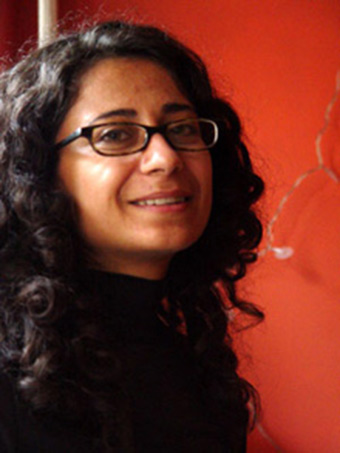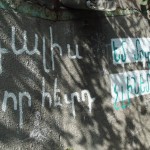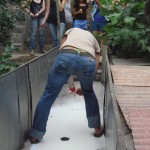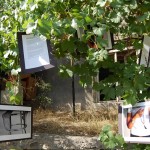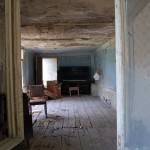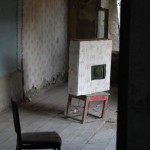12th year 2008/09
Lectures Curatorial Practices 3
Thursday, January 14, 2010 at 7pm
Project Room SCCA, Metelkova 6, Ljubljana
Aesthetic experience has a political effect to the extent that the loss of destination that it presupposes disturbs the way in which bodies fit their functions and destinations. What it produces is no rhetoric persuasion about what has to be done. Nor is it the framing of a collective body. It is a multiplication of connections and disconnections that reframe the relation between bodies, the world where they live and the way in which they are ‘equipped’ for fitting it.[1]
When I set to prepare this paper on Women-Oriented-Women’s network in Armenia in relation to the issue of queer aesthetics, I had a clear position I wanted to articulate. The memories of WOW’s first exhibition – Coming to You Not to Be With You in Yerevan still fresh (Fig. 1), I wanted to retrieve the experience of doing collective work with artists and writers within the framework of this exhibition. It was my desire to construct an inter-subjective topography of the exhibition we organized together in the summer of 2008 in Yerevan. What I had in mind was to recuperate the collective experience of labor, precisely the experience of producing art as a laborious collective process, which resulted in an inter-subjective exchange between the participants in terms of constructing relationships, strengthening and rearticulating friendships. I wanted to refer to the experience of working together with artists and writers within the framework of WOW as constitutive of a possible/impossible collective, which functioned through dissensus rather than consensus, a collective which came into being through a dialectic of reunion and partition, through aggressive gestures to call the other to share a common space, and through an equivocal refusal to share that space, while reflecting vulnerability and fragility at the very heart of the subject.
As the temporal distance from the original event increased, I felt the need to not only question and critique my own role in the construction of queer discourses understood as identitarian associations in Armenia but also to interrogate the very possibility of subjectivisation within the dialectic of reunion and partition. What if subjectivisation fails? What if adopting pre-established and pre-defined regimes of identification and identitarian associations developed under radically different historical conditions resulted in the impossibility of subjectivisation? Here I will try to conceptualize the space and some of the possibilities that could emerge between the attempts of subjectivisation and its very failure, on the example of WOW’s exhibition Coming to You Not To Be With You.
This text attempts to construct a topography of non-subjectivisation and the failure of desire to become a vehicle in the construction of collectives and communities. This multi-layered narrative is comprised of factual information about WOW as a collective – the modes of communication and interaction which might or might not result in collectively coming together, my own commentaries derived from my subjective experiences within the group and my political commitments. I have made use of various voices: these are fragments of speeches, utterances, visual references, which participate in the formation of the collective. The text is self-reflective towards the theoretical framework adopted for interpretation, and it contains a meta reflection upon the very narrative of writing, which I call ‘topographical curating’, as a way of reading art works and constructing an aesthetic experience through the very work of interpretation.
PASSAGE 1: Jacque Rancière takes up Stéphane Mallarmé’s notion ‘apart we are together’ from the French writer’s short story The White Water Lilly to discuss the ways in which the aesthetic experience has a potential to create a dissentual community through a double separation: the physical separation of the art work from its maker, the subjective and social separation of the artist from the viewer, and the viewers from each other. This very violent separation of work from the community, a loss of destination of art is that which marks the aesthetic condition of an artwork.
‘Apart we are together’. There are two interpretations of the formula. On the one hand there is that anticipation of the being together of the community in the being apart of the work. On the other hand, there are works that try to explore the very tension between the two terms, either by questioning the ways in which the community is tentatively produced or by exploring the potentials of community entailed in separation itself.[2]
‘Apart we are together’ is a condition of modernity that functions through individuation, through isolating the subject and creating spaces of solitude in order to forge a coming together of a community. In its core, it relates to a specific mode of aesthetic experience and forges dissensual communities. Rancière continues: ‘The ontology of the dissensual actually is a fictional ontology, a play of ‘aesthetic ideas’. The set of relations that constitutes the work plays as if it had another ontological texture than the sensations that make up everyday experience.’[3] Then, according to Rancière, dissensus is a sensorial rupture between our everyday sensory experiences, and that which is produced through aesthetic experience.
WOW-Women-Oriented-Women’s loose network was established in 2007, or rather it was never established since it has mostly functioned through networks of virtual communication – a blog and a list-serve, materializing only from time to time, situationally. It is comprised of women artists, writers and activists who live in Armenia or the Armenian Diaspora and many of whom, including myself, left the group while I was originally preparing a version of the current text for a conference presentation.
The umbrella project under which the collective’s initiatives are grouped is entitled Queering Yerevan, which functions through a double-problematization: complicating the given spatio-temporal coordinates of the urban structure of the Armenian capital and problematizing the word queer. Though with some lapses to identity politics, the word queer has been largely understood as offering a particular perspective and an estranging look, which sheds a different light upon already familiar phenomena. At times, members come from radically different backgrounds: there are those who were born and live in Armenia where homosexuality has not been a part of mainstream or even marginal discourses until very recently, those who were born and grew up in Armenia but are now located elsewhere, those who are second or third generation immigrants in North America and also those who grew up in the Diaspora but have expatriated to Armenia during the last five or six years. Given the different historical and cultural backgrounds of its members, the very structure of WOW called for a community that did not pursue a collective agenda and was not united by a single cause. The diverse backgrounds and inherently singular experiences of its members initially made it impossible to identify the collective’s agenda in narrowly defined terms. While the local Armenian artists evolved throughout the late 1990s and 2000s established friendships, produced works and exhibited together without any discourse of homosexuality or queerness informing their works, those members who grew up in North America often contributed through clearly defined politics of identity – be that of national or gender identity. At times the group communication became a struggle to obtain the right to name and frame the group’s ‘true and authentic’ politics and to outline its agenda, to create cohesion and identity.
I believe that in the specific context of Armenian artists’ communities the politics of identity as well as approaching sexuality as in itself implying transgression and subversion can have unwanted consequences for contemporary artists’ and other communities subjectivisation within the mainstream culture. These ‘minority’ discourses threaten to ultimately form a coherent ‘us’ and appear as the progressive peripheries against ‘them’ – the mainstream culture, which is defined as regressive and conservative. Thus this oppositional dynamic reinforces center and periphery, margins and mainstream division legitimizing the dominant culture as a ‘core text’. I believe that in the specific context of Armenia queer aesthetic communities cannot afford to detach themselves from the dominant culture – for cultural, social as well as economic reasons. Any act of detachment and fragmentation through particularization of identities could result in the atomization, enclosure and alienation of communities and abandoning the struggle over representation. Here I am not arguing for unity and consensus but for antagonism and dissensus which is resistant, but which, however, offers an affirmative vision. I believe that the dynamic of ‘coming to you not to be with you’ epitomizes WOW’s situatedness within a larger social and cultural context to which it belongs but at the same time does not belong.
Artistic subjectivisation, if it is to offer any empowerment for these communities and if it is understood as a process of dissociation and disindetification rather than identity and recognition, can open up a space for a truly emancipatory politics through aesthetics itself, rather than through an overarching political cause. The collective has been operating as an anti-institution, or rather as an association of individuals while attempting to resist the seduction to be packaged and exoticized as ‘Armenian’, ‘women’ and ‘queer’. It has attempted to circumvent the economy of desire conditioned by the functioning of the international art market on the one hand, and instrumentalized by international funding bodies, civil society groups or progressive politics to advance a specific identity cause on the other.
PASSAGE 2: Lusine Talalyan: What I’m afraid of most is that we (as a collective) might become an instrument, that not only they do not critique or label us, but on the contrary, support us financially, presenting themselves as advocates of progressivism. This implies glamorizing and normalizing what is queer and turning us into their ideological tokens. In the first case with labeling, I think that it’s possible to have or to create a genuine dialog, whereas in the second case the opportunity for a dialog is lost. This is why it was so important that we didn’t have any international organizations that supported us financially; we did everything through our own means and abilities.
I approach WOW first and foremost as an aesthetic community rather than a community that shares a common political cause striving for identity and recognition. I believe that by precisely defining it as an aesthetic community it is possible to salvage its truly political potential. I am also well aware that this definition is not merely a conceptualization or interpretation of the collective but an attempt to frame it, to direct its orientation and have an impact upon its politics. I hold that what aesthetics and anti- or beyond identitarian politics share is a possibility of political subjectivisation through aesthetics and by extent, if we remember Rancière’s ‘Apart We Are Together’, through disidentification. According to Rancière, ‘The aesthetic effect first is an effect of des-identification. The aesthetic community is a community of des-identified persons. As such, it is political since a political subjectivization goes through a process of des-identification.’[4]
Collective Topography
PASSAGE 3: In ‘You Tell Me’ architectural historian Jane Rendell offers ‘site-writing’, a spatial narrative constructed through topographical fiction and existing visual codes within a space informed by subjective experiences.[5] However, this space itself is never a given but comes into being through the embodied experience. Site-writing is not a writing about spaces but writing spaces, engaging with the works through their own spatiality and positioning. In this, not only the critic positions herself and her body in relation to the works, but the way the works are positioned becomes significant:
In art criticism this approach demands that the critic investigates the position s/he occupies in relation to works, the locations those works refer to and the spatial issues they raise, not only conceptually and ideologically, but also materially and emotionally, in order to produce texts that locate the spatial themes of the art works in written form.[6]
Then, site-writing or topography is a constant move back and forth, between the inside and the outside – the works with which the critic engages invite her inside but also define her as always external. This brings me back to Rancière’s theorization of ‘Apart We are Together’ as the space of dissensus opened up by aesthetic separation, and I could also extend it to argue that the very relationship of partition and reunion arises from a topographical engagement with the works, as always apart but also with/within us.
I would like to extend Rendell’s critical model and apply it to curating. More than anyone else, the curator’s prime occupation is to position works in a specific space; the latter not only understood as a specific architectural configuration but also as a historical field in which meaning is constructed and contested. Then, the curator is not someone who is external to the art works or someone whose task is to bring out and show the artist’s implied meaning but someone who engages the aesthetic language of the art works, assembles them, rearranges, rewrites and re-interprets in order to produce a space for experience: a space filled with and constructed by other bodies, coming together, staying apart, appearing and disappearing, both ephemeral and material. In a way, topographic curating can happen in a given space and time – ‘really’ – but it can be also constructed post-factum, such as within the framework of this text, and each time differently, but always working with the spatial coordinates of specific works within a specific space and the curator’s subjective engagement with these works.
The project Coming To You Not to be With You is topography of failed desire, the impossibility to stay together as a community, relentless attempts to construct a common space and the impossibility to share that space. It abandons the notions of visibility, while being the first project in Armenia to bring together works of lesbian, bisexual and heterosexual artists in relation to queerness or I would rather call it estrangement, since this implies a double translation – queer into the Armenian word – տարօրինակող and back into the English word estrangement. It is topography of a failure to come out, to open up and to be queer; a topography of enclosed and isolated spaces – empty constructions, of the obsessive attempts of re-territorialization. It is not accidental that the title Coming to You Not To Be With You replaced the original conception of the project: Self-Mapping: Queering the City; the latter being an umbrella concept for WOW’s activities in general, a form of a mission statement. The original conception was about opening the self to experience the city as a phantasmic geography, to map it through personal memories, sites of encounters, coming together and breaking up, through the possibility of subjectivisation.
PASSAGE 4: Shushan Avagian circulated an email in which she described an exhibition of self-mapping at the Art Institute of Chicago, and out of this, a conversation developed about Queering the City. I replied: ‘What I am interested is not the city as it really is but as it exists in our consciousness, in our imagination, or as we see it, feel it and perceive it through our bodies. I think that there is a radical potential in this kind of different, diverse conception of the city –imagining, interpreting and claiming the space of the city through our own memories and on our terms … To broaden the idea of mapping, we can also question the recent architectural changes in the city and the forms of desire and subjectivity that they prescribe.’ Lusine Chergeshtyan responded: ‘We could base our self-mapping on the topography of love and relationship: memories that record chronologically where and when we first talked about homosexuality, spaces in which we have had positive experiences and felt free, or spaces that have confined or oppressed us, spaces where we met and formed a group, where we found allies who understood us and whom we understood …’ Astghik Melkonyan began to conceive her self-mapping in terms of performance art: ‘There will be silhouettes of couples. I haven’t decided how many, but they are going to be life-size, or maybe not so large. They will be on the ground. I will use flour sieved through a kitchen flour sifter. Which means I’ll have to make a large template and use the flour to achieve the stenciled image … I want to have several images in several places and I need people to be able to interact with those images …’
I walk through the garden where Coming to You Not To Be With You took place, as a participant-curator, as an accomplice, as a critic, as an outsider and a friend. I mentally walk through the garden while physically located in my apartment in Cairo, with a distance of eight months from the original event. This is an imaginary walk, affected by the current politics of WOW and my personal interest to shift the orientation of the group from identity discourses to creating possibilities for a truly emancipatory politics through an aesthetic experience. I try to look for answers and possibilities in the summer exhibition– the only physical, non-virtual instance in which the collective came together not only to produce art but to labor together, to forge bonds and relationships through work. This included discussions, cleaning of the garden with shovels and hoes during the hot summer, smoking way too many cigarettes and consuming too much caffeine (Fig. 2). I look back with the hope of finding an emancipatory potential in the collective’s coming together through a common aesthetic experience as a shared space rather than forging bonds through the politics of a common identity.
In the middle of the garden, after stepping over the disappearing traces of Astghik Melkonyan’s performance (Fig. 3) in which she sieved flour on a template of two women figures, passing through Adrineh Boghossian’s fragments of the photographed self (Fig. 4),Lusineh Chergheshtyan’s almost hidden and barely visible attempts at bodily communication and without yet reaching the audience who came to the opening and is attentively following Shushan’s and my conversation, I come across to an abandoned house that has been there for a thousand and one years (Fig. 5).
PASSAGE: Shushan writes: A room with old Soviet wallpaper, an old piano that desperately needs tuning, two broken windows, an ancient magnetic tape player, a video of two women playing football with a watermelon in a pool (Fig. 6). Parts of the wallpaper are reapplied, the patterns are changed, deliberately (and inconspicuously) made into irregular patterns, the kinds of irregularities you look for when as a child you’re staring at the wall, while trying to fall asleep, tracing the patterns with your eyes and matching the lines in symmetrical forms … only a keen eye can detect the irregularities. You can find them only when you look for them, when you know that they are there – the subversive forms, the lines that are discontinuous, the paths that lead nowhere, patterns that are not symmetrical. The installation can be called ‘my mother’s room’.
The half-ruined construction from another age, a decadent monument to the impossibility to remember the past as it is. This work by Arpi Adamyan and Lusineh Talalyan is an anti-monument, which mourns without remembering, a ready made-ornament with a vague and undefined sense of loss, and without memory. It is an assemblage of a ready-made anti-monument and a technological intervention to revitalize the space, to invite the viewer in, while foreclosing the possibility of an entry. The past is so obscured that it resists any work of reconstruction. I can enter the space through the semi-decayed window frame and the collapsing front door: however, this entry never takes place through invitation; it is too dangerous to enter this space – both literally and figuratively. This is a useless space, which calls in but does not accommodate, which refuses recognition and identification; it is not an abject space in which the residue and waste of society can nourish a potential to undo dichotomies but a space which is full of void and emptiness, which can not be utilized and reused and in which meaning or signification collapses. The space closes itself off rather than invites in – it refuses to incorporate the reality coordinates of my everyday life, and by this fact, it is a phantasmic space which refuses symbolization, thus subjectivization. Within the space of the exhibition – inhabited with works, inhabited with other bodies and meaning, the empty room appears as a cavity, as a wound, as an abyss which does not promise redemption. This is a space of total disindetification, epitomizing the very impossibility to relate to the other and to identify with the other. This is not a space of dialogue and reciprocity but of isolation and solitude. While Shushan Avagian and myself introduce our collective and the exhibition to the audience, this work simultaneously cancels our utterances. In the way of being a space of dissensus, this is an aesthetic space par excellance, and by extent – this is an estranged (queer) space in that it destabilizes the look and cancels signification. However, paradoxically, as Rancière claims: ‘Constructing a place for solitude, an ‘aesthetic’ place appears as a task for engaged art.’[7]
Spring 2009
P.S. Approximately three years after this article was written and presented at the World of Art program at SCCA−Ljubljana, the WOW collective still operates through the blog Queering Yerevan. However, as most of the original members left due to their discontent with the identity politics propagated by some of the founding members, the group has been largely articulating a negative critique upon other contemporary artists’ works through appropriation and actual acts of erasure and negation. The possibility of subjectivisation and specifically, the potential to offer an alternative understanding of artistic practice and communal aesthetic experience has been foreclosed for the sake of a hypertrophic notion of the individual who heroically betrays the very context in which it operates.
Winter 2012
[1] Jacques Rancière, ‘Aesthetic Separation, Aesthetic Community: Scenes from the Aesthetic Regime of Art’, Art and Research, Vol. 2., No. 1., Summer 2008.
[2] Ibid.
[3] Ibid.
[4] Ibid.
[5] Jane Rendell, ‘You Tell Me’, Public Spheres After Socialism (ed. Angela Harutyunyan, Katherine Horschelmann and Malcolm Mile, Intellect, 2008, pp. 71–87.
[6] Ibid., p. 83.
[7] Rancière, Ibid.
